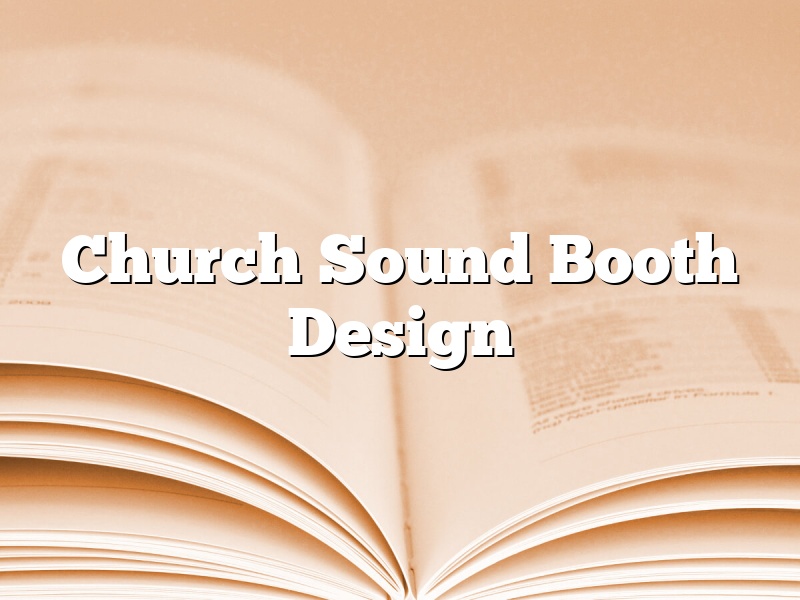Church Sound Booth Design
Church sound booth design has always been a critical factor in how well a church service sounds to the congregation. Poorly designed sound booths can lead to echoes and other audio problems that can be very distracting. A well-designed sound booth can help to ensure that the congregation hears the pastor and other speakers clearly and without distortion.
There are a few key factors to consider when designing a church sound booth. The first is the size of the booth. It should be large enough to accommodate the equipment and personnel needed to run the sound system. The booth should also be large enough to provide ample sound damping, so that echoes and other audio problems are minimized.
The shape of the booth is also important. It should be designed to minimize the amount of sound that escapes the booth. This can be done by using sound-damping materials on the walls and ceiling, and by using sound-absorbing materials on the floor.
The type of equipment that will be used in the booth also needs to be considered. The equipment should be positioned so that it is easy to use and so that it does not create any noise or interference problems.
The final factor to consider is the acoustics of the room. The sound booth should be positioned so that it does not interfere with the natural acoustics of the room. If possible, the booth should be located in a corner or against a wall, so that it does not create any additional echoes.
When designing a church sound booth, it is important to consider all of these factors. By taking into account the size of the booth, the shape of the booth, the type of equipment that will be used, and the acoustics of the room, it is possible to create a sound booth that will provide the best possible sound quality for the church congregation.
Contents
Where should the sound booth be in a church?
When it comes to sound in a church, the right balance is key. Too much or too little sound can be a distraction or even make it difficult to hear the preacher. So, where should the sound booth be in a church?
Ideally, the sound booth should be located in a place where it can control the sound for the entire church. This means it should be placed in a spot where it can best reach all the areas of the church. If the sound booth is located in a corner or off to the side, it may not be able to properly reach the entire church. This can lead to an unbalanced sound throughout the church.
Another thing to consider is the size of the church. If the church is large, the sound booth will need to be larger in order to properly cover the entire space. If the church is small, a smaller sound booth may be sufficient.
Ultimately, the best place for the sound booth will vary depending on the specific church. However, the booth should be placed in a spot where it can best control the sound for the entire church.
How do I set up a church sound system?
Setting up a sound system for a church can be a daunting task. There are many factors to consider when making this purchase, such as the size of the room, the type of worship service, and the budget.
The most important factor to consider is the size of the room. The sound system needs to be able to fill the room with sound without creating too much feedback or distortion. In general, the bigger the room, the larger the sound system you will need.
Another important factor to consider is the type of worship service. If the service includes a band or choir, you will need a more sophisticated sound system than if the service is just a sermon.
Finally, consider your budget when selecting a sound system. There are many affordable options available, but you will need to decide what features are most important to you.
Once you have considered these factors, it is time to start shopping for a sound system. There are many different brands and models to choose from, so it is important to do your research and find the system that best meets your needs.
Here are some tips for setting up a church sound system:
1. Start by setting up the main speakers. These should be placed at either side of the stage, or at the front and back of the room, depending on the size of the room.
2. Next, set up the monitors. These speakers should be placed on the stage so that the performers can hear themselves properly.
3. Add the subwoofer to the mix. This speaker will add extra bass to the sound system.
4. Make sure to set up the microphone and mixer. The mixer will allow you to control the sound of the microphones and the speakers.
5. Connect the sound system to a power source and turn it on. Test the sound in the room and make any necessary adjustments.
Once the sound system is set up, it is important to test it regularly and make any necessary adjustments. The worship service will sound much better if the sound system is properly tuned and calibrated.
How do you mix good church sounds?
Church sound systems are a vital part of any religious service. Not only do they provide a clear way for the pastor to be heard by the congregation, they also add ambiance and atmosphere to the proceedings. If your church is looking to upgrade its sound system, or if you’re just starting out and are unsure of how to mix good church sounds, read on for some tips.
The first step in setting up a sound system for your church is to determine the type of service you will be holding. Are you primarily holding traditional services with a choir and sermon? Or are you more of a contemporary church with a band and lots of singing? Each type of service will require a different type of sound system.
Once you’ve determined the type of service you’re holding, it’s time to start thinking about the sound that you want to create. Do you want a clear, crisp sound for the pastor to be heard? Or do you want a more ambient, atmospheric sound? Once you know what you’re aiming for, you can start to purchase or set up the necessary equipment.
In general, you will need a few key pieces of equipment for your church sound system. These include a microphone for the pastor, speakers for the congregation, and a sound mixer to control the sound levels. Other equipment, such as a choir mic, may be necessary depending on the type of service you’re holding.
Once you have all of your equipment, it’s time to start setting it up. Be sure to test the sound levels in advance to make sure everything is working properly. You may need to make some adjustments to the sound mix to achieve the desired effect.
Church sound systems can be a daunting topic, but with a little bit of knowledge and some trial and error, you can create the perfect sound for your church services.
How do you set up a church equalizer mixer?
Setting up a church equalizer mixer can seem daunting, but with the right instructions it can be a relatively easy process. In this article, we will outline the steps necessary to set up a church equalizer mixer.
The first step is to determine how many channels your mixer will need. This will depend on the number of microphones you plan to use. If you are using a standard stereo microphone, you will only need two channels. If you are using a six-channel microphone, you will need six channels.
Once you have determined how many channels your mixer will need, you will need to determine the signal flow. This can be a little more complicated, but with a little experimentation you should be able to figure it out. The basic idea is that the signal flows from the microphone, to the mixer, and then to the amplifier.
The next step is to connect the mixer to the amplifier. This is usually done with a pair of cables called XLR cables. One end of the cable goes into the mixer, and the other end goes into the amplifier.
Once the mixer is connected to the amplifier, it is time to connect the microphones. This is done with another type of cable called a TRS cable. One end of the cable goes into the microphone, and the other end goes into the mixer.
Once the microphones are connected, it is time to test the mixer. This can be done by turning on the power and making sure all the levels are correct. You should also test the sound by singing or talking into the microphones.
Once the mixer is set up, it is time to start using it. Just remember to keep the levels under control, or you might end up with a lot of noise.
How many watts do I need for a church speaker?
Church sound systems can be complex, with a variety of components that all work together to create an immersive worship experience. While it’s important to have a good understanding of all the pieces of a church sound system, this article will focus specifically on the question of how many watts you need for a church speaker.
Church sound systems can be used for a variety of purposes, including music, preaching, and announcements. The wattage you need for a church speaker will vary depending on what you’re using it for. If you’re using the speaker for music, you’ll need more watts than if you’re using it for announcements.
Generally speaking, you’ll need at least 50 watts for a church speaker that will be used for music. If you’re using the speaker for announcements, you’ll only need about 10 watts.
It’s important to keep in mind that the wattage requirements for a church speaker can vary depending on the size and type of the speaker. If you’re not sure how many watts you need, consult the specifications for the speaker you’re interested in.
When choosing a church speaker, it’s important to consider not only the wattage requirements, but also the size and type of the speaker. If you’re not sure which speaker is right for you, consult a church sound specialist for help.
How do you set up a stage sound system?
Setting up a stage sound system can be a daunting task, but with a little knowledge and preparation, it can be a relatively easy process. The first step is to identify the components that are necessary for your system. This will vary depending on the size and type of stage, but typically, you will need a mixer, amplifiers, speakers, and cables.
The mixer is the central component of the sound system, and it is responsible for routing the sound signal to the amplifiers and speakers. The amplifiers increase the signal strength so that it can be heard by the audience, and the speakers convert the signal into sound waves. Cables are used to connect the mixer to the amplifiers and speakers.
Once you have identified the components needed for your system, the next step is to determine the placement of the components. The mixer should be positioned in the center of the stage, and the amplifiers and speakers should be placed on the sides of the stage, facing the audience.
Once the components are in place, the next step is to connect the cables. The mixer should be connected to the amplifiers, and the amplifiers should be connected to the speakers. It is important to ensure that the cables are properly connected and that there is no undue strain on the connectors, as this can damage the equipment.
Once the cables are connected, the system should be tested to make sure that it is functioning properly. This can be done by playing a sound clip or song and making sure that the sound is being broadcast to the audience. If there are any problems, they can be corrected before the show begins.
Setting up a stage sound system can seem like a daunting task, but with a little knowledge and preparation, it can be a relatively easy process. By following these simple steps, you can create a sound system that will allow your audience to enjoy the show.
How do you balance church sounds?
Church sound systems can be a great way to amplify the sound of your worship services, but they can also be difficult to balance. Here are a few tips to help you get the best sound possible in your church.
The first thing to consider is the tone of your voice. You want to make sure that you are speaking loudly enough for the entire congregation to hear. However, you also don’t want to shout. Try to find a happy medium between speaking too softly and speaking too loudly.
Another thing to consider is the location of your sound system. You want to make sure that the speakers are facing the congregation, not the walls or the floor. If the speakers are facing the wrong way, the sound will be muffled and it will be difficult for the congregation to hear.
You also need to make sure that the sound level is consistent throughout the church. If one side of the church is louder than the other, it will be difficult for people to hear. You may need to adjust the sound level on individual speakers to make sure that the sound is balanced.
Finally, you need to make sure that the music and the sermon are in sync. If the music is too loud or too soft, it will be difficult for people to focus on the sermon. Try to find the right balance between the music and the sermon so that everyone can hear and understand what is being said.
Church sound systems can be a great way to improve the quality of your worship services, but it can be difficult to get the balance right. These tips should help you to get the best sound possible in your church.




